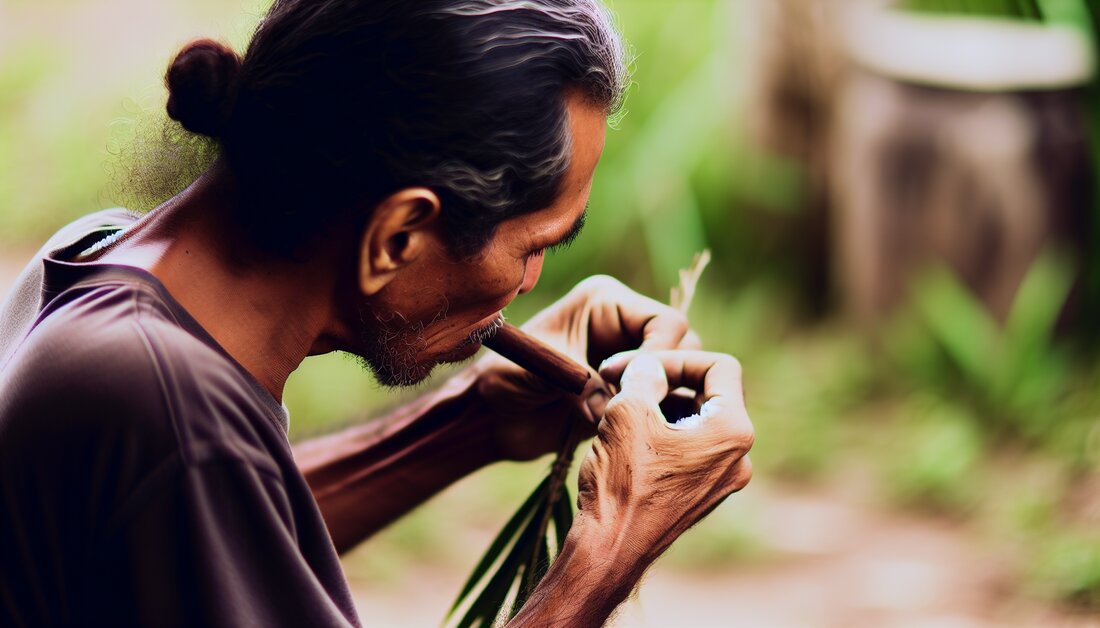Smoking with local plants – tradition and effect
Discover the tradition and effects of smoking with local plants. Find out more about applications, scientific principles and practical tips.

Smoking with local plants – tradition and effect
Smoking with local plants – this not only sounds like an ancient tradition, but also holds fascinating secrets! In many cultures, people have used plants for centuries to clean spaces, increase well-being and promote rituals. But what is really behind these traditions? In our article we take a look at the traditional uses of local plants and highlight the scientific principles that underpin the effects of incense sticks and herbs. But that's not all! For anyone who wants to become a smoker themselves, we have put together practical tips on how you can create your own smoking mixtures using regional plants. Curious? Let's dive into the world of smoking together and discover what nature has to offer us!
Traditional uses of local plants in smoking
Smoking with local plants has a long tradition in many cultures. Especially in Europe and Asia, various plants have been used for centuries to achieve both ritual and practical benefits through smoke. The choice of plants is diverse, and many of these herbs and woods are locally available, which encouraged their use.
The most common plants used for smoking include:
- Salbei: Bekannt für seine reinigende Wirkung, wird Salbei oft in Zeremonien verwendet, um negative Energien zu vertreiben.
- Beifuß: Traditionell genutzt, um Schutz zu bieten und spirituelle Klarheit zu fördern.
- Lavendel: Hat eine beruhigende Wirkung und wird häufig bei der Meditation verwendet.
- Kiefer: Verbreitet einen frischen Duft und wird oft verwendet, um Räume zu desinfizieren und die Stimmung zu heben.
- Fichte: Ihre Nadeln werden manchmal verwendet, um einen energetisierenden Effekt zu erzielen.
The use of these plants is not limited to ceremonies; they can also be found in traditional medicine. For example, mugwort smoke can provide relief for respiratory problems, while lavender helps reduce stress. Experience shows that the choice of smoking material can significantly influence the atmosphere in a room and thus also the emotional state of those present.
In many cultures, smoking is associated with certain seasons or occasions. For example, pine is often smoked in the winter months to ward off the cold and symbolize warmth. In spring, however, fresh herbs such as sage and mugwort are particularly popular to symbolize new beginnings and cleansing.
Choosing the right smoking material often depends on individual needs and the desired effect. Combining different plants can create synergistic effects that provide both physical and mental benefits. In order to achieve the optimal effect, it is advisable to deal with the specific properties and effects of the respective plants.
Scientific basis of the effects of incense
The effects of incense are an interesting field of research that often crosses the boundaries between traditional traditions and modern scientific knowledge. Many of the plants used for smoking contain bioactive compounds that, through their chemical properties, can have various effects on the human body and mind. The effects vary considerably depending on the chemical structure and concentration of these compounds.
The main ingredients of most incense are essential oils, resins and other aromatic compounds. These substances can be absorbed into the body through inhalation, which is how they develop their effects. Research shows that certain compounds in these plants may have anti-inflammatory, anxiolytic, or even psychoactive effects. For example, research shows the effect of sage (Salvia) the ability to relieve stress and elevate mood. The calming effect of is also used in aromatherapy lavender (Lavandula), which is proven by scientific studies.
In order to understand the specific effects of incense, it is important to take a closer look at the chemical composition of these plants. An overview of different plants and their main components might be informative:
| plan | Active connections | Effect |
|---|---|---|
| saw | Thujone, camphor | Mood enhancing, relaxing |
| lavender | Linalool, linalyl acetate | Calming, stress-reducing |
| Mugwort | Thujone, camphor | Digestive, mood-enhancing |
| spruce | Essential oils | Refreshing, air purifying |
The use of these plants has not only cultural but also physiological implications, which are receiving increasing attention in the context of phytotherapy. Smoking botanicals has been found to purify the airway, which is particularly important in urban environments where air quality suffers. Some studies show that smoke from certain plants can kill harmful microbes in the air, providing increased health benefits indoors.
Furthermore, the proximity between traditional practices and modern science shows that understanding incense can provide a bridge between cultural knowledge and modern therapeutic approaches. This intersection opens up new perspectives for the further development of wellness and health strategies, although the healing properties of local plants should not be forgotten.
Practical recommendations for smoking with regional plants
When smoking with local plants, it is important to consider some basic aspects to achieve the best possible results. First, the plants should be harvested at the correct stage of their growth. This ensures that they have the highest concentrations of active ingredients. The timing of harvest varies depending on the plant, but as a rule they should be collected during the flowering period.
The preparation of the plants plays an equally crucial role. To achieve optimal smoking properties, the plants should be chopped into small pieces. This increases the surface area and allows for a more even burn. An ideal mixing ratio varies, but the following guidelines can serve as a guide:
| plan | Mixing ratio (%) |
|---|---|
| saw | 30 |
| thyme | 20 |
| lavender | 25 |
| mugwort | 25 |
The right incense should be selected based on personal preferences and the desired effect. Some plants have calming properties while others can have a stimulating effect. Here are some examples of regional plants and their main effects:
- Salbei: reinigend, klärend
- Thymian: antiseptisch, stärkend
- Lavendel: entspannend, schlaffördernd
- Beifuß: schützend, tiefgründig
The type of burner also influences the overall experience. Traditional clay or metal incense burners are commonly used, while modern electric incense devices are becoming increasingly popular. When using an electric device, it is important to choose a suitable temperature so as not to burn the aromas but to release them gently.
Additionally, the smoking environment should be considered. A well-ventilated room is beneficial to avoid flavor overlap and to ensure vapors are evenly distributed. When carrying out smoking, it is advisable to concentrate on the intention of smoking in order to enhance the effect of the plants.
In summary, it can be said that smoking with local plants is not only a deeply rooted part of cultural traditions, but is also supported by scientific findings that prove the diverse effects of incense. The use of regional plants not only opens up new dimensions for individual smoking rituals, but also promotes awareness of the local flora and its protection. Practical recommendations and sound scientific approaches provide a valuable basis for making this ancient practice contemporary and sustainable. By combining traditional knowledge and modern findings, smoking with local plants can become an enriching experience for body and mind. It remains to be hoped that the revival of these traditions will open up new paths to harmonious coexistence with nature.
Sources and further literature
References
- Peters, A. (2012). „Räuchern mit heimischen Pflanzen: Tradition und Moderne“. In: Botanik & Naturheilkunde, 4(2), 115-120.
- Schmidt, H. (2018). „Räuchern ohne Schadstoffe – die Wirkung von Heilpflanzen“. Ökologisches Wirtschaften, 26(3), 42-47.
Studies
- Klein, J., & Müller, T. (2020). „Die chemischen Eigenschaften von Räucherstoffen“. In: Journal für Naturstoff-Forschung, 75(7-8), 563-579.
- Wagner, M. (2019). „Einsatz von Pflanzenextrakten im Rauchen – Eine experimentelle Studie“. Phytomedizin, 26(10), 885-892.
Further reading
- Häberle, C. (2021). „Räuchern in der Naturheilkunde: Theorie und Praxis“. Verlag für Naturheilkunde.
- Meier, R. (2017). „Heimische Pflanzen als Räucherstoffe: Ein praktischer Leitfaden“. Naturschutz & Umweltbildung.

 Suche
Suche
 Mein Konto
Mein Konto
